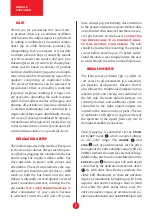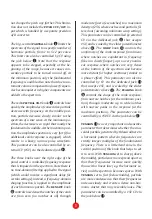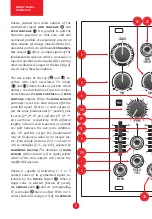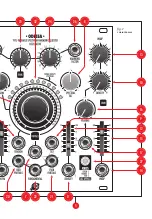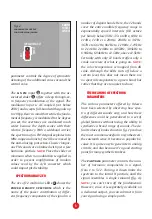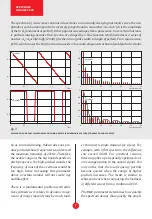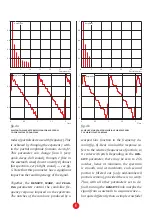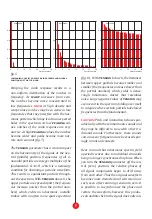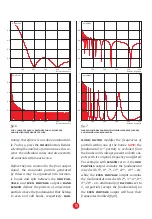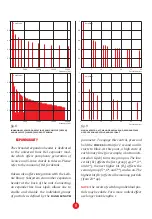
Warping the comb response results in a
non-uniform distribution of the notches in
frequency. As warp increases from zero,
the notches become more concentrated in
low frequencies.
note:
at high density and
warp values, notches may be so dense in low
frequencies that they interfere with the har-
monic pattern which may lead to unexpected
holes in the spectrum. At low peaking val-
ues, notches of the comb response are very
narrow. At high peaking values, the notches
become wider and peaks become more nar-
row and resonant (fig. 7).
The tension parameter has a crucial impact
on the harmonicity of the signal. At the neu-
tral (middle) position, frequencies of all si-
nusoidal partials are integer multiples of the
fundamental: F
n
=n×F
1
, which is a necessary
condition for obtaining a periodic waveform.
This results in equidistant partials through-
out the spectrum. With tension above 0, the
upper partials are spread apart (the frequen-
cies increase quicker than the partial num-
bers) which yields an inharmonic, metallic
timbre with an often more sparse spectrum
(fig. 8). With tension below 0, the distances
between upper partials become smaller and
smaller (the frequencies increase slower than
the partial numbers) which yields a dense,
rough, inharmonic cluster that resembles
noise. Large negative values of tension may
even result in the spectrum folding over itself
to a degree where certain partials have lower
frequencies than the fundamental.
caution:
Pitch and intonation behaves par-
adoxically with these inharmonic sounds and
they may be difficult to tune with other tra-
ditional sounds. Furthermore, these sounds
can cause ear fatigue and are best used spar-
ingly in musical contexts.
Bear in mind that inharmonic spectra yield
aperiodic waves due to individual sinusoids
being no longer synchronized in phase. When
you turn the tension parameter off the cen-
tral (zero) position, the relative phases of
all signal components begin to drift away
from each other. Thus the original waveform
becomes more distorted and will remain as
such, even after returning tension to zero. It
is possible to re-synchronize the phase and
restore the waveform, however, this produc-
es an audible click in the signal due to discon-
9
Amplitude
Amplitude
5 10 15 20 25 30
Partial number
0
1
0.8
0.6
0.4
0.2
5 10 15 20 25 30
Partial number
0
1
0.8
0.6
0.4
0.2
5 10 15 20 25 30
Partial number
0
1
0.8
0.6
0.4
0.2
Amplitude
fig. 5
comparison of tilted spectra in extreme and middle
positions of the tilt knob


